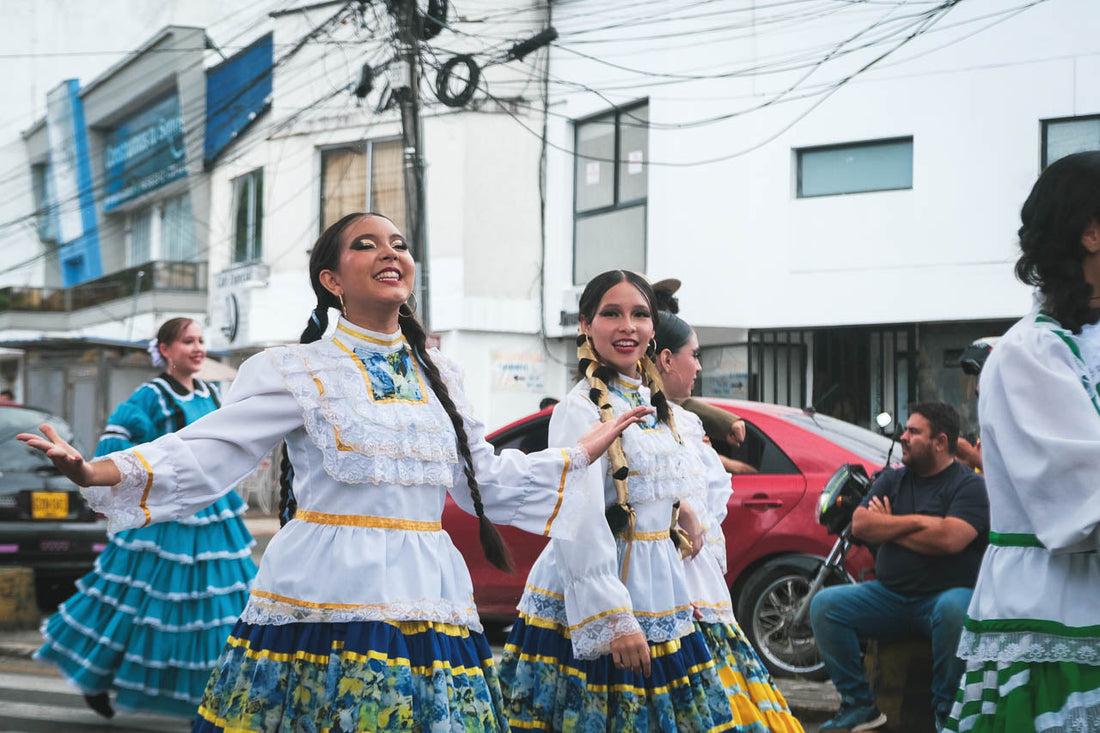
Six Months of Waiting: Finding Home at the Desfile Cuyabro
Share
Armenia, Quindío | Las Fiestas de Armenia 2025
The Question I Carried

Six months ago, I landed in Armenia with a camera and a question I wasn't sure I wanted answered: Could I still feel at home in a place I'd been away from for so long?
I'd marked Las Fiestas de Armenia on my calendar the day I arrived in May. 136 years since this city's founding, and somehow it felt like the perfect moment to test whether Colombia still felt like mine. Whether the years away had created too much distance. Whether coming back was about nostalgia or something real I could still touch.
Saturday gave me the answer in color, music, and faces I won't forget.
What It Means to Be Cuyabro

The Desfile Cuyabro isn't just a parade. It's 136 years of identity walking down Carrera 14, refusing to stay quiet.
Being cuyabro means you're from Quindío, from coffee country. It means you carry your heritage the way the performers carried those massive floral arrangements through the streets—with your whole body, with effort, with visible pride. These aren't lightweight decorations. They're structures built from thousands of fresh flowers, balanced on wooden frames, carried on backs that have trained for this moment.
It's pride that doesn't apologize. It's knowing your roots run as deep as the coffee plants covering these hillsides.
I'm not cuyabro. I'm from Ibagué, just over the mountains. But watching this parade, I felt like I was seeing my own country with new eyes. Sometimes you need to step slightly outside your own region to see what makes Colombian culture so layered, so particular to each place.
The Parade That Stops a City

Armenia shuts down for this. Not metaphorically. The main avenues close. Families claim their spots on the curbs hours early. Vendors sell everything from chuzos to sombreros. The whole city becomes an audience.
The floats rolled by like moving art installations. Beauty queens in sequined costumes waved from platforms flanked by golden condors and jaguars, symbols of the region's natural heritage. Each float told a story about coffee, about the land, about what it means to belong to this specific corner of Colombia.

Then came the moments that hit differently. An older man pedaling a hand-decorated cart, religious figures carefully arranged beside him, a Barranquero Bird perched like it had been part of the family for decades. His willys wasn't flashy. It was personal. It was history on wheels.
This is what the parade does. It makes space for both spectacle and intimacy. For the grand floats sponsored by businesses and the individual expressions of faith, tradition, and creativity.
The Dancers Who Turned Streets Into Stages

If you've never seen Colombian folk dancers perform in the street, you're missing something. These aren't rehearsed stage performances. They're full-body celebrations happening on asphalt, in the middle of traffic, surrounded by thousands of people.
The dancers in golden dresses spun so hard their skirts became wheels of color, catching every bit of available light. The ones in white with embroidered details smiled like they'd been waiting all year for this exact moment. And maybe they had.
Their faces told the whole story. This wasn't performance. This was joy. This was "we're exactly where we want to be."
Coffee Culture in Motion

Then came the Jeep that made me stop taking photos for a second just to watch.
A bright red Willys overflowing with plantains, coffee baskets, and tropical flowers. Painted across the hood: "Raíces Cafeteras." Coffee roots. It wasn't subtle. It didn't need to be.
This is the Eje Cafetero. Coffee built these towns. It shaped the economy, the architecture, the way people relate to land and work. And the parade doesn't let you forget it. Every few floats, there's another reference to coffee culture—the jeeps that haul beans down mountain roads, the canastos woven by hand, the machetes that harvest the cherries.
It's a moving tribute to everything this land gives, and everything people here have built with their hands.
The Joy That Felt Contagious

What got me most wasn't the spectacle. It was the faces.
The Afro-Colombian dancers with towering headdresses that seemed to defy physics. Their costumes were explosions of color—yellow, orange, black, every shade vibrant against the overcast sky. But more than the visual impact, it was the energy. The way they moved like they were channeling something bigger than themselves. The way they smiled so wide you could feel it from across the street.
Everyone was smiling like they'd been waiting all year for this moment. Performers, yes. But also the families on the sidewalks. The kids on their parents' shoulders. The elderly couples who probably hadn't missed a parade in decades.
That's what the Desfile Cuyabro does. It turns a city into a collective memory being made in real time.
Why I Came Back
These 20 photos barely scratch the surface, but they remind me why I returned to Colombia after being away.
It's easy to carry a version of home in your head—the one you remember, the one that might not exist anymore. Coming back always risks disappointment. What if the place changed? What if you changed too much?
But Colombia doesn't just exist in memory. It lives in moments like these, when a whole city shuts down to celebrate exactly who they are. No apologies. No explanations for outsiders. Just "this is us, and we're showing up fully."
I left Colombia over 24 years ago chasing other dreams. But these fiestas pulled me back into something I'd almost forgotten—the feeling of belonging to a place that doesn't just welcome you. It wraps you up in color and music and says "you're ours."
The Answer
If you've ever left home and wondered whether you'd still recognize it when you returned, I get it.
Sometimes you need a parade to show you what you've been missing.
Sometimes you need to see strangers carry flowers through the street with their whole body, dancers spin until their dresses blur, and a city stop everything just to remember its own story.
Armenia gave me my answer on Saturday. I'm home. Maybe not cuyabro, but close enough to feel it.
